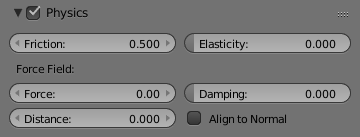Game Materials¶
Game Settings¶

Game Settings panel.
This panel contains properties that control how the object surfaces that use the material are rendered in real-time by the Blender Game Engine.
- Backface Cull
- Hide the back-faces of objects rendered with this material. If “Off”, both sides of the surface are visible (at the expense of lower rendering speed). Note that this setting is applied per material and not per face; e.g. if the material is applied to a cube, only the back and front faces of the cube are visible, and not both sides of each face.
- Invisible
- Hide all faces of objects rendered with this material.
- Text
- Use material as Text object in the Game Engine.
- Alpha Blend
Controls how the alpha channel is used to create a transparent texture in the rendered image.
- Alpha Sort
- Orders the sequence in which transparent objects are drawn on top of each other, so that ones in front receive more light than ones behind.
- Alpha Blend
- Uses the alpha values present in the bitmap image sourced in the Image slot.
- Alpha Clip
- Uses the alpha channel as a simple mask.
- Add
- Render face transparent and add color of face.
- Opaque (default)
- All alpha values are ignored; the scene is completely non-transparent.
Face Orientation¶
Provides options regarding the orientation (i.e. rotation transformation) of faces to which the material is applied.
- Shadow
- Faces are used for shadow.
- Billboard
- Billboard with Z-axis constraint.
- Halo
- Screen-aligned billboard.
- Normal (default)
- No transformation.
Material Physics¶

Panel Physics in Material context.
This panel contains physical properties that control how the object surfaces that use the material are rendered in real-time by the Blender Game Engine.
Physics settings are visible when using the Game Engine for rendering, and handled by the Game Engine’s physics engine.
- Friction
- Coulomb friction coefficient when inside the physics distance area.
- Elasticity
The elasticity of collisions determines how much of the kinetic energy is retained after the collision. A value of 1 will result in a collision where objects bounce off each other, and the kinetic energy after the collision is the same as before. A value of 0 will result in a collision where the objects stick together after the collision, as all energy will have been converted to heat (or other energy forms that Blender also does not model).
In macroscopic nature (so bigger than atomic particles) an elasticity of 1 is never seen, as at least some energy is converted to heat, sound, etc. An elastic (elasticity=high) collision occurs when two metal balls collide. An inelastic (elasticity=low) collision is seen when two half-inflated beach balls collide.
- Force Field
Controls force field settings.
- Force
- Upward spring force when inside the physics distance area.
- Distance
- Distance of physics area.
- Damping
- Damping of the spring force when inside the physics distance area.
- Align to Normal
- Align dynamic game objects along the surface normal when inside the physics distance area.